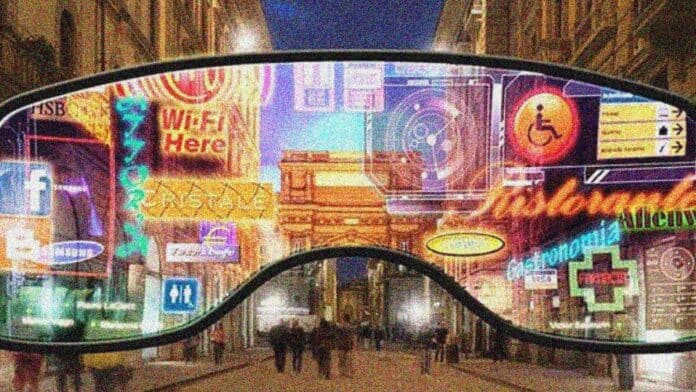Augmented reality (AR) is a technology that allows computer-generated digital content to be overlaid in the real-world environment in real-time. It uses sensors, cameras, and other devices to collect data about the user’s surroundings and then projects digital information onto it, creating an immersive experience. In this article explore how AR is rapidly gaining popularity and is being used in a wide range of applications, from entertainment to healthcare to education.
Contents
What is Augmented Reality?
Augmented reality (AR) is a technologically augmented version of the real world that is created through the use of digital visual elements, music, or other sensory stimulations. It’s a developing trend among businesses that deal with mobile computing and commercial apps. One of the augmented reality’s key goals, among the expansion of data collecting and analysis, is to highlight certain elements of the physical environment, raise comprehension of those features, and generate sensible and accessible insight that can be used in real-world applications.
History of Augmented Reality
The concept of Augmented Reality was first introduced in 1968 by Ivan Sutherland, who invented a head-mounted display that could overlay computer graphics onto the real world. However, the technology was not practical at that time due to the limited processing power and graphics capabilities of computers.
It wasn’t until the late 1990s that AR technology became more practical, thanks to advances in computer graphics and the development of mobile devices. The first AR application for a mobile device was created in 2008 by the Japanese company Tonchidot, which launched the app “Sekai Camera” which used a smartphone’s camera to overlay digital information onto the real world.
Since then, AR has continued to evolve and has become more widespread, with companies like Apple, Google, and Microsoft investing heavily in AR technology.
How Augmented Reality Works?
AR works by using sensors and cameras to capture data about the user’s environment. This data is then processed by software algorithms that identify the user’s location and orientation in the real world.
Once the user’s location and orientation have been identified, digital content can be overlaid in the real world using a variety of methods. This can include projecting images onto a surface, displaying digital information on a screen, or using a head-mounted display to create an immersive experience.
AR can also use sensors and other devices to track the user’s movements, allowing digital content to be adjusted in real time as the user moves around the environment.
Applications of Augmented Reality
AR has a wide range of applications across many different industries. Here are a few examples:
- Entertainment: AR is being used in video games and other forms of entertainment to create immersive experiences for users. For example, the popular game Pokemon Go uses AR to overlay digital creatures onto the real world, allowing users to catch them as they move around their environment.
- Education: AR is being used in education to create interactive learning experiences for students. For example, AR can be used to create virtual models of objects, allowing students to explore them in greater detail.
- Healthcare: AR is being used in healthcare to create simulations that allow doctors to practice surgical procedures in a safe, controlled environment. AR can also be used to create visualizations of medical data, allowing doctors to better understand complex medical information.
- Advertising: AR is being used in advertising to create interactive experiences for consumers. For example, AR can be used to create virtual try-on experiences for clothing or makeup, allowing consumers to see how they would look without having to physically try on the product.
- Fitness: Smart glasses provide performance metrics, map navigation, and safety features for activities like running and martial arts. Apps like Pokemon Go and Jurassic World Alive have also incorporated fitness elements.
- Military: Rockwell International used video map overlays to aid space observations at the Air Force Maui Optical System. In 2003, the US Army integrated the SmartCam3D AR system into the Shadow Unmanned Aerial System to detect people or points of interest using telescopic cameras. The system merges geographic information with live footage, with a “picture in picture” mode to display a synthetic view of the area for better situational awareness. A robot mine-detecting sensor combines metal detectors and ground-penetrating radar to discover mines or IEDs, which is valuable for saving lives.
- Music: Augmented reality could revolutionize music production, mixing, control, and visualization. A 3D music program allows DJs to play sound samples in 3D space. Leeds College of Music developed an AR program for use with Audient mixing desks, allowing students to layer information or interactivity on top of the desk with their mobile devices. Additionally, money is software that uses AR to help people learn an instrument.
Challenges and Limitations of Augmented Reality
While AR has a lot of potential, there are also challenges and limitations to the technology. Here are a few examples:
- Hardware Limitations: AR requires a lot of processing power and specialized hardware, which can make it expensive and difficult to implement on a large scale.
- User Experience: AR can be a very immersive experience, but it can also be disorienting for some users. This can make it difficult to create experiences that are accessible and enjoyable for everyone.
- Privacy Concerns: AR can collect a lot of data about the user’s environment and behavior, which can raise privacy concerns. There is a need for clear guidelines and regulations around the collection and use of this data.
- Integration Challenges: AR requires integration with existing systems and technologies, which can be a complex and challenging process. This can make it difficult for organizations to implement AR on a large scale.
Scope of Application Possibilities
Many uses for augmented reality have been investigated, ranging from gaming and entertainment to medicine, education, and business. Archaeology, architecture, trade, and education are some of the application fields. Augmented reality has been utilized to help surgery by giving virtual overlays to guide medical practitioners, as well as AR content for astronomy and welding. The 2015 International Conference on Virtual, Augmented, and Mixed Reality.
Conclusion
Augmented reality is a rapidly growing technology that has the potential to transform many industries. While there are challenges and limitations to the technology, continued advancements in hardware and software are making AR more accessible and practical. As AR becomes more widespread, it will be important to address issues around privacy, user experience, and integration to ensure that it is used in a safe and responsible manner.
Sources
- Cawood, S., & Fiala, M. (2007). Augmented reality: a practical guide.
- Javornik, A. (2016). The mainstreaming of augmented reality: A brief history. Harvard Business Review (online version).
- “How Augmented Reality Works” by HowStuffWorks
- Porter, M. E. (2021, July 14). How Does Augmented Reality Work? Harvard Business Review. https://hbr.org/2017/11/how-does-augmented-reality-work#:~:text=Augmented%20reality%20starts%20with%20a,which%20analyzes%20the%20video%20stream.
- “The 10 Biggest Augmented Reality Challenges Facing AR Developers in 2021” by AR Insider
- “What is Augmented Reality (AR)?” by Techopedia
FACT CHECK: We strive for accuracy and fairness. But if you see something that doesn’t look right, please Contact us.
DISCLOSURE: This Article may contain affiliate links and Sponsored ads, to know more please read our Privacy Policy.
Stay Updated: Follow our WhatsApp Channel and Telegram Channel.














